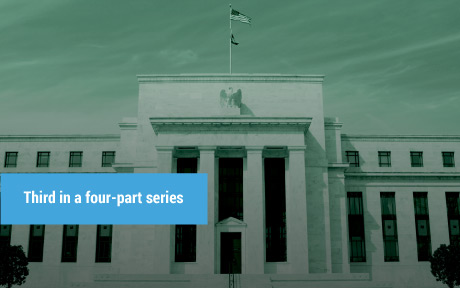A Closer Look at the Fed’s Balance Sheet Accounting

An earlier post on how the Fed changes the size of its balance sheet prompted several questions from readers about the Federal Reserve’s accounting of asset purchases and the payment of principal by the Treasury on Treasury securities owned by the Fed. In this post, we provide a more detailed explanation of the accounting rules that govern these transactions.
How the Fed Changes the Size of Its Balance Sheet: The Case of Mortgage‑Backed Securities

In our previous post, we considered balance sheet mechanics related to the Federal Reserve’s purchase and redemption of Treasury securities. These mechanics are fairly straightforward and help to illustrate the basic relationships among actors in the financial system. Here, we turn to transactions involving agency mortgage-backed securities (MBS), which are somewhat more complicated. We focus particularly on what happens when households pay down their mortgages, either through regular monthly amortizations or a large payment covering some or all of the outstanding balance, as might occur with a refinancing.
How the Fed Changes the Size of Its Balance Sheet

The size of the Federal Reserve’s balance sheet increased greatly between 2009 and 2014 owing to large-scale asset purchases. The balance sheet has stayed at a high level since then through the ongoing reinvestment of principal repayments on securities that the Fed holds. When the Federal Open Market Committee (FOMC) decides to reduce the size of the Fed’s balance sheet, it is expected to do so by gradually reducing the pace of reinvestments, as outlined in the June 2017 addendum to the FOMC’s Policy Normalization Principles and Plans. How do asset purchases increase the size of the Fed’s balance sheet? And how would reducing reinvestments reduce the size of the balance sheet? In this post, we answer these questions by describing the mechanics of the Fed’s balance sheet. In our next post, we will describe the balance sheet mechanics with respect to agency mortgage-backed securities (MBS).
The Role of Central Bank Lending Facilities in Monetary Policy

Central bank lending facilities were vital during the financial crisis of 2007-08 when many banks and nonbank financial institutions turned to them to meet funding needs as private funding dried up. Since then, there has been renewed interest in the design of central bank lending facilities in the post-crisis period.
How Do Central Bank Balance Sheets Change in Times of Crisis?
Historical Echoes: A Central Bank by Any Other Name Is Still . . .
Amy Farber Perhaps you enjoy being read to out loud. Perhaps you enjoy being read to on subjects related to central banking. Perhaps you would enjoy being read the Wikipedia entries for central banks around the world. If so, and your reader was to read the following beginning sentences for central bank entries, you would […]
Historical Echoes: Central Bank and Paper Money Innovator Given Death Sentence for His Efforts
In 1668, Johan Palmstruch, the head of Stockholms Banco, the precursor to the oldest central bank still operating today—the Swedish Riksbank—was charged and sentenced to death, according to Wikipedia and the Riksbank.
Just Released: Chairman Bernanke Returns to His Academic Roots
Federal Reserve Chairman Ben Bernanke is back in the classroom this month to deliver a series of four lectures for undergraduate students at the George Washington School of Business in Washington, D.C.












 RSS Feed
RSS Feed Follow Liberty Street Economics
Follow Liberty Street Economics